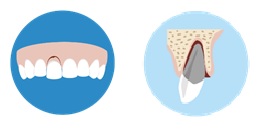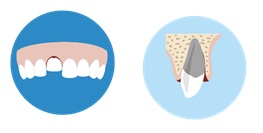Traumatic dental injury. Trauma with tooth luxation
PARTIALLY DISLODGED TOOTH FROM THE ALVEOLAR BONE (EXTRUSION)
In case of extrusion the tooth has not completely dislodged from the alveolar bone after trauma, the tooth appears longer compared to the other teeth.

Actions at the scene of the accident
- Gently try to place the tooth back to its original position.
- Gently bite down on a napkin or gauze to anchor your tooth.
- It is recommended to visit a dentist urgently or within 24 hours.
- Due to delaying the treatment, the probability of placing the tooth in the correct position is reduced and later orthodontic treatment may be necessary.
TOOTH THAT HAS MIGRATED INTO THE ALVEOLAR BONE (INTRUSION).
In case of intrusion, the tooth has migrated into the alveolar bone. The tooth appears significantly shorter compared to the other teeth. Sometimes the tooth may not be visible at all.

Actions at the scene of the accident
- Place a clean gauze or napkin on the injured teeth and bite down gently to close your mouth.
- It is recommended to visit a dentist urgently or within 24 hours.
- Due to delaying the treatment, the probability of placing the tooth in the correct position is reduced.
- In children, if a permanent tooth has been displaced into the socket and does not erupt on its own within 2 weeks of the trauma, orthodontic tooth extrusion is necessary.
DISLODGED TEETH (LATERAL LUXATION)
Sometimes the bone of the surrounding teeth (alveolar process) is damaged in the event of trauma. In this case, teeth can migrate to the front, back or laterally.
Actions at the scene of the accident
- Gently try to place the tooth back into its original position.
- Gently bite down on a napkin or gauze to anchor your tooth.
- It is recommended to visit a dentist urgently or within 24 hours.
- Due to delaying the treatment, the probability of placing the tooth in the correct position is reduced and later orthodontic treatment may be necessary.
AT THE DENTIST’S APPOINTMENT
If possible, the dentist will fix the tooth into the correct position, the teeth are stabilized with the splint and root canal treatment is initiated within two weeks as necessary (see patient information: Root canal treatment). If it is impossible to reinstate the tooth back in the correct position, the patient is referred to a surgeon/orthodontist, if necessary.
FOLLOW-UP VISITS:
2 weeks, 4 weeks, 8 weeks, 3 months, 6 months and one year after the trauma, then yearly for the following 5 years.
Be sure to book your follow-up visits.
The splint should be removed within 2-4 weeks after the trauma. Failure to do so will worsen the prognosis.
TREATMENT PROGNOSIS AND POSSIBLE COMPLICATIONS AFTER TRAUMA
Treatment of repositioned teeth is mostly successful. Common complications are tooth nerve death, root fusion (resorption) or ossification (ankylosis), tooth colour or position alterations, and gum recession. Unfortunately, it is not always possible to save the tooth.
Please note: If you experience facial trauma outside of dentist office hours please go to the emergency department to receive emergency treatment. In case of extensive injuries call an ambulance or go to the emergency department at once.
POST-TREATMENT INSTRUCTIONS AFTER DENTAL TRAUMA
- Kindly avoid sports and physical exercise following the trauma in the mouth.
- Consume soft foods in the next two weeks and avoid biting and chewing on hard substances. It is recommended to chew with the opposite side of the mouth.
- Maintain excellent oral hygiene: brush teeth twice a day with a soft toothbrush and fluoride-containing toothpaste; clean contact surfaces of uninjured teeth with dental floss and interdental brush. As a result of poor oral hygiene, gingivitis may occur and worsen the prognosis of treatment.
- Especially ensure the proper oral hygiene of the injured area! During the first week, it is recommended to perform oral hygiene procedures after each meal.
- If the teeth were immobilized with the splint, carefully clean the area around it with interdental brushes and dental floss.
- Don’t touch the traumatised area with your tongue or fingers.
- Rinse your mouth with chlorhexidine mouthwash twice a day for 1-2 weeks.
- Apply 0,2% chlorhexidine gel on the wound with a clean cotton or gauze pad 2-3 times a day.
- Take over-the-counter analgesics as necessary. Adults: 400 mg to 600 mg of ibuprofen and/or 500 mg to 1000 mg of paracetamol every 6 to 8 hours (or other over-the-counter analgesics). Please note: For children the dosage has to be adjusted according to their body weight.
- Antibacterial treatment is indicated for tooth avulsion (complete removal of the tooth from the mouth) and soft tissue injuries.
In case your condition worsens or you have any questions, please contact your dentist or healthcare facility.
Authors: Dr. Valeria Hameury, Dr. Teele Paltsar, Dr. Marjo Sinijärv and Dr. Anna Firsova
2023